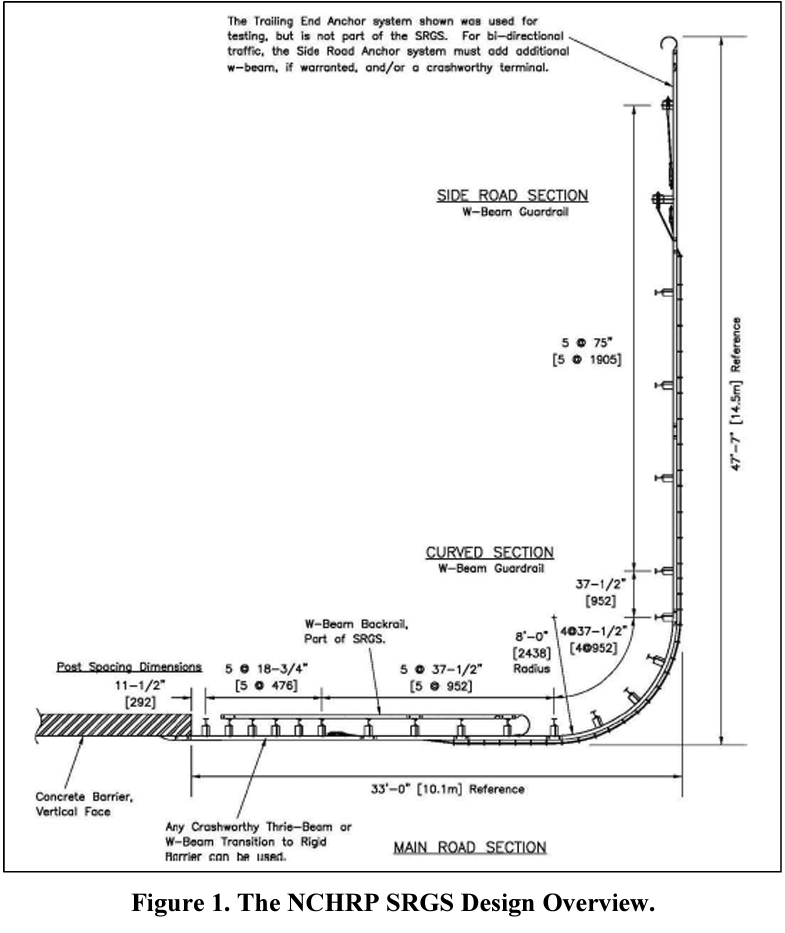| TTI Research Supervisor: Akram Abu-Odeh, PhD. Research Scientist Texas A&M Transportation Institute Texas A&M University System TAMU 3135, College Station, Texas, 77843-3135 (979) 317-2628 [email protected] | Pooled Fund Technical Representative: Tim Moeckel Roadside Safety Engineer WSDOT Development Division Washington State Department of Transportation P.O. Box 47329 Olympia, WA 98504-7246 (360) 704-6377 [email protected] |
States have a long-standing problem when trying to provide crashworthy barrier systems at intersection locations where a side road or driveway intersects a bridge/structure on a major road in close proximity to the bridge/structure end. Often, the close proximity does not allow enough room to properly install a barrier that can shield both the bridge/structure end and the slope immediately adjacent to it. As a result of this issue, a project funded by National Cooperative Highway Research Program (NCHRP, Powers et al. [1]) recently developed the American Association of State Highway and Transportation Officials’ (AASHTO’s) Manual for Assessing Safety Hardware (MASH) compliant Short Radius Guardrail System (SRGS) which provides an excellent intersection barrier system option for states. The system referred to as the “NCHRP SRGS” utilizes 10-guage W-beam rails and steel posts at a 90-degree intersection angle as shown in Figure 1. The overall length from the bridge rail and/or barrier end to the face of guardrail running perpendicular to the main roadway alignment is 33-ft. Currently, the NCHRP SRGS is MASH Test Level 3 (TL-3) compliant on flat ground, and MASH TL-2 compliant with a 2:1 or flatter slope behind it (tested at 50 mph). Based on the simulation conducted by Powers et al. [1], the system with 2:1 slope has high possibility of failing tests with an impact speed of 90km/h (55.9 mph) or higher speed (MASH TL-3 tests) due to less stable, and significant roll and pitch angle of the vehicle. Therefore, there are still opportunities to explore and improve upon the SRGS system to make it more effective and available for use at a higher number of locations, and easier/more cost-effective to construct with a design modification. A preliminary survey of the Pooled Fund states showed the greatest amount of interest in conducting MASH TL-3 testing on SRGS with a 2:1 slope any required design modifications. 
The objective of this project is to develop a MASH TL-3 compliant SRGS system with a 2:1 slope behind the system based on the design developed by the NCHRP 15-53 project (Powers et al. [1]). This will involve design modifications for the SRGS achieved through additional computer modeling simulations.
The TTI research team will provide a final report that will include design details of a modified SRGS design to meet MASH TL-3 specifications that is ready for MASH crash testing.
The work plan for this research includes three (3) tasks as described below:
Task 1: Literature Review and State Survey:
In Task 1, the TTI research team will conduct a literature review to comprehensively assess existing barrier intersection systems, specifically focusing on the Short Radius Guardrail System (SRGS). This review also encompasses an evaluation of a guardrail system with a slope ratio of 2:1 or steeper, as well as related components like transition devices. By examining these aspects, the aim is to gather a thorough understanding of past practices and technologies.
Task 2: Design and Simulation Analysis
In Task 2, the TTI research team will conduct a multi-faceted approach to design and simulation analysis. First, it entails the development, calibration, and validation of a Finite Element (FE) model using data from the NCHRP MASH TL-2 tests and other relevant test sources. This foundational step ensures the accuracy and reliability of the model. Simultaneously, the TTI research team will propose SRGS design options to incorporate a 2:1 slope in accordance with MASH TL-3 specifications. Subsequently, the TTI research team will conduct FE simulations using the validated vehicle models (a pickup truck and a small car) to evaluate the performance of the modified SRGS, considering MASH Tests 3-33 and 3-32 criteria. The analysis extends to investigating the SRGS with a shorter length primary road section and aiming to identify potential optimizations in design. This comprehensive approach helps pinpoint critical tests and crucial impact points for the specific SRGS chosen by the Technical Advisory Committee (TAC), enabling informed decision-making and the enhancement of safety measures.
Task 3: Reccommend Design and Reporting
In Task 3, the TTI research team will prepare the documentation that includes background research, computer simulations, engineering drawings, and implementation guidance. To advance the project, consider options for the next phase, including field testing, cost-benefit analysis, stakeholder feedback, comparative studies, and regulatory compliance checks to further evaluate the SRGS.
REFERENCES
